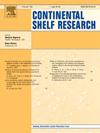谱波作用下岛礁形态动力响应的数值研究
IF 2.2
3区 地球科学
Q2 OCEANOGRAPHY
引用次数: 0
摘要
大多数现有研究报告说,在全球气候变化的背景下,许多低洼的珊瑚礁环礁岛屿容易受到海平面上升和风暴增加的影响。这些岛礁是否对如此极端的海洋条件作出了积极的调整,还有待进一步验证。本研究采用开源的XBeach数值模型,利用其相分辨非静力模块(XB-NH)及其形态动力学模块,研究波谱下岛礁的形态动力学响应。首先用两组已发表的数据集对模型进行了验证,其中包含和不包含位于礁滩上的沙岛。然后应用该模型研究了一系列入射波强迫条件(有效波高、峰值波周期、礁面水深)和岛屿初始形态特征(岛屿高度、岛屿顶宽、岛屿滩坡、岛屿位置)对礁岛形态动力学演化的影响。模型应用表明,岛礁波峰升高和整个岛屿的泻湖迁移是两种主要的形态动力学响应,波浪变大,水位升高。在离礁缘较近、滩坡较陡的小岛上,也会出现一到两次形态动力学的自我调节。这些见解突出了在低洼珊瑚礁环礁国家的沿海管理中考虑岛屿形态特征以更好地解决其未来稳定性和持久性的必要性。本文章由计算机程序翻译,如有差异,请以英文原文为准。
A numerical study of the morphodynamic response of reef islands under spectral waves
Most existing studies reports that many low-lying reef atoll islands are vulnerable to the sea level rise and increased storminess in the context of global climate change. The positive adjustment of these reef islands to such extreme oceanographic conditions still needs to be further verified. In this study, the open-source XBeach numerical model using its phase-resolving nonhydrostatic module (XB-NH) combined with its morphodynamic module is adopted to investigate the morphodynamic response of reef islands under spectral waves. The model is firstly validated by two published datasets with and without the presence of sandy island located on the reef flat. The model is then applied to examine the effects of a series of incident wave forcing conditions (significant wave height, peak wave period, reef flat water depth) and island initial morphological features (island height, island top width, island beach slope, island location) on the morphodynamic evolution of reef island. Model applications show that two main morphodynamic responses: the elevated reef island crest and the lagoonward migration of the whole island are identified with larger waves and increased water level. One or two of such morphodynamic self-adjustment can be also found for smaller island with steeper beach slope located more closer to the reef edge. These insights highlight the necessity to consider the island morphological features in the coastal management of low-lying reef atoll nations to better resolve their future stability and persistence.
求助全文
通过发布文献求助,成功后即可免费获取论文全文。
去求助
来源期刊

Continental Shelf Research
地学-海洋学
CiteScore
4.30
自引率
4.30%
发文量
136
审稿时长
6.1 months
期刊介绍:
Continental Shelf Research publishes articles dealing with the biological, chemical, geological and physical oceanography of the shallow marine environment, from coastal and estuarine waters out to the shelf break. The continental shelf is a critical environment within the land-ocean continuum, and many processes, functions and problems in the continental shelf are driven by terrestrial inputs transported through the rivers and estuaries to the coastal and continental shelf areas. Manuscripts that deal with these topics must make a clear link to the continental shelf. Examples of research areas include:
Physical sedimentology and geomorphology
Geochemistry of the coastal ocean (inorganic and organic)
Marine environment and anthropogenic effects
Interaction of physical dynamics with natural and manmade shoreline features
Benthic, phytoplankton and zooplankton ecology
Coastal water and sediment quality, and ecosystem health
Benthic-pelagic coupling (physical and biogeochemical)
Interactions between physical dynamics (waves, currents, mixing, etc.) and biogeochemical cycles
Estuarine, coastal and shelf sea modelling and process studies.
 求助内容:
求助内容: 应助结果提醒方式:
应助结果提醒方式:


